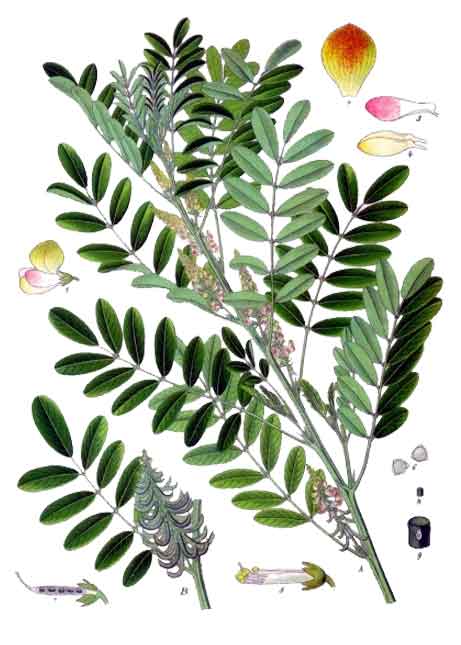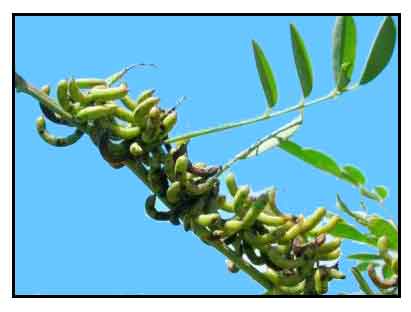 Botany Botany
Tayum is an erect, branched, half-woody plant, 1 meter or less in height. Stems are sparsely covered with short, appressed hairs. Leaves are 5 to 8 centimeters long. Leaflets are 9 to 11, oblong to elliptic-oblong, 1 to 2 centimeters in length, pale, and appressed-hairy beneath. Flowers are red, about 5 millimeters long, borne on axillary and solitary racemes 2 to 3 centimeters in length. Pods are numerous, crowded, reflexed, strongly curved, 1 to 1.5 centimeters long, containing 6 to 8 seeds.
Distribution
- In waste places in and about towns, locally abundant, occasionally cultivated, from the Batan Islands and northern Luzon to Mindanao.
- Pantropic.
Constituents
- Indigo: One of the sources of natural indigo; along with Indigofera tinctoria, represents the chief indigo of commerce.
- Preliminary studies of leaves, seeds, and stems yielded polyphenols (coumarin and chlorogenic acid) and flavonoids (quercetin, rutin, and gallic acid), alkaloids, triterpenoids, and carbohydrates.
(18)
- Phytochemical screening yielded alkaloids, iridoids, saponins, carbohydrates, coumarins, flavonoids, phenol, terpenoids, and indigo carmine, sterol and essential oils (linalool and pinene).
- Phytochemical screening of leaves yielded reducing sugar, tannin, flavonoid, phenol, alkaloid, glycoside, and steroid. (see study below) (15)
- GC-MS analysis of leaves yielded the presence of nine different phytochemical compounds viz., pentadecanoic acid,14-methyl-,methyl ester (5.86%), n-hexanedecanoic acid (9.83%), z-[13, 14- epoxy]tetradec-11-en-1-ol acetate(6.37%), oleic acid(10.43%), 9-octadecenoic acid[z]-,2-hydroxy-1-[hydroxyl methyl]ethyl ester(10.21%), heptanoic acid, docosyl ester(6.28%), octadecanoic acid, 7-hydroxy-, methyl ester(4.89%), 6-octadecenoic acid[z]-(18.47%), and 8-octadecenoic acid, methyl ester(14.97%). (18)
- Main flavonoids identified from methanol extract of leaves include quercetin 7-O-β-d-glucopyranoside, quercetin 3-O-[β-d-xylopyranosyl-(1⟶2)-β-d-galactopyranoside], quercetin 3-O-[α-l-rhamnopyranosyl-(1⟶6)-β-d-glucopyranoside], and quercetin 3-O-[β-d-glucopyranosyl-(1⟶2)-β-d-glucopyranoside. (18)
Properties
- Considered febrifuge, vulnerary, purgative, antispasmodic, diuretic, stomachic.
- Studies have suggested antifungal, antibacterial, antitumor, antimycobacterial, mosquitocidal, immunostimulatory, gastroprotective properties.
Parts used
Seeds, roots, leaves.
 Uses Uses
Folkloric
- Bruised leaves used as anodyne in warm baths.
- Decoction of leaves used as sudorific.
- Aztecs used the seeds for urinary diseases and ulcers.
- Poultice of seeds applied to the head for fever.
- Whole plant used as a remedy for syphilis.
- Used for epilepsy.
- In Brazil, a reputed remedy for snake bites.
- In the U.S., applied to stings of bees and other insects.
- In Mexico, leaves used as cataplasm or decoction, applied to child's forehead for fever, or other painful areas.
- Powdered seeds used for ulcers.
- Tincture of roots and seeds infused in rum used for destroying vermin on the human body. Root decoction used for stomach ache.
Plant juice used for treatment of diarrhea. (19)
Others
- Manure: In Malaya and Java, used to be cultivated as green manure.
- Dye: Source of indigo dye.
- Cover crop: Also used as a perennial cover crop for coffee.
- Cosmetics: Extract of leaves and stems used as ingredient in commercial preparations of skin conditioners. (19)
Studies
• Antibacterial / Antifungal / Leaves: Studies of various extracts of Indigofera suffruticosa showed the aqueous extract of leaves with strong inhibitory activity against S aureus and against dermatophyte strains - Trichophyton rubrum and Microsporum canis. Results suggests aqueous extracts of leaves of IS by infusion can be used as treatment of dermatophytic skin diseases. (1)
• Mutagenicity: Flavonoid and alkaloid fractions showed mutagenicity. The alkaloid fraction contained indigo and indirubin; indigo was found mainly responsible for the mutagenic activity. Results also suggest that indiscriminate use of homemade preparations of the plant can be dangerous to health, and that natural products, like synthetic medicines, need to be evaluated with regard pharmacologic properties, toxicity, dosage and safety. (2)
• Antitumor / Leaves: Aqueous extracts of leaves of Indigofera suffruticosa showed a tumor reducing activity on Sarcoma 180 in mice. The actual mechanism is not known, but the antitumor activity may be due to its interference with cell development. (3)
• Embryotoxicity: In a study of the aqueous extract of leaves of IS for adverse effects in preimplantation mouse embryos showed embryotoxicity effects that suggest use of AELIs may be hazardous to humans who make use of it in folk medicine. (4)
• Antimycobacterial: A study evaluated the antimycobacterial activity and innate immune response of methanol and dichlormethane extracts of I. suffruticosa. Results showed induction of innate immune response through the production of high levels of NO and TNF-α (p<.001) suggesting a possible important immunological role in TB control once macrophage activity is induced. (5) (13)
• Mosquitocidal / Repellent / Embryotoxicity / Leaves: A study of aqueous extract of I. suffruticosa leaves showed repellent activity, specific embryotoxicity, and general growth retardation in Aedes aegypti (6).
• Immunostimulatory / Cytotoxic Activities: Study of an alkaloidal fraction and a pure alkaloid indigo showed cytotoxic activity against both breast and lung adenocarcinoma cell lines. Results showed immunostimulatory and cytotoxic activity of IS, enhancing macrophage function and contributing to host defense against tumors. (7)
• Gastroprotective / Ulcer Healing: Study of methanolic extract of IS in a rodent experimental model investigated ulcer healing and gastroprotective effects via mucus and gastric secretion. Results showed the AcF accelerated ulcer healing, acting as gastroprotective agent stimulating prostaglandin, mucus and heat shock protein (HSP70) . (8)
• Anticonvulsant / GABAergic / Leaves: Study a methanol extract of leaves of Indigo suffruticosa for anticonvulsant effect. Results showed an anticonvulsant effect, attributed, at least partly, with involvement of GABA-BDZ system. (11)
• Molluscicidal Activity / Leaves: Study evaluated the molluscicidal effect against Schistosoma mansoni life cycle. An aqueous extract showed a dose-dependent toxic effect against the mollusk, suggesting a potential natural product as molluscicidal agent. (12)
• Antimicrobial / Leaves: Study of ethanol extract of leaves showed significant antimicrobial activity against bacteria (S. aureus, E. coli, P. aeruginosa, K. pneumonia) and fungi (Aspergillus niger and C. albicans). (see constituents above). (15) Study evaluated various organic and aqueous extracts of Indigo suffruticosa for antimicrobial activity against 5 different human pathogenic bacteria and 17 fungal strains by agar-solid diffusion method. Most of the extracts were devoid of antimicrobial activity, except for the aqueous extract of leaves which showed strong inhibitory activity against gram positive S. aureus with MIC of 5000 µg/ml. The MIC to dermatophytic strains were 2500 µg ml against Trichophyton rubrum and Microsporum canis.(24)
• Anti-Inflammatory: Study evaluated the anti-inflammatory potency of I. suffruticosa and its mechanisms of action in lipopolysaccharide (LPS)-induced RAW 264.7 macrophages. Results showed strong anti-inflammatory property with diminution of pro-inflammatory mediator expressions by lessening LPS-induced NF-kB activation and inducing HO-1 expression in macrophages. (16)
• Antimicrobial / Synergism with Erythromycin Against S. aureus / Leaves: Study evaluated the antimicrobial activity of different leaf extracts of I. suffruticosa against nine clinical isolates of S. aureus and their synergistic effects with erythromycin. All organic solvent extracts showed antimicrobial activity against S. aureus strains. The acetone extract showed most potent inhibition of S. aureus with MIC and MBC of 3.12 and 6.25 mg/mL, respectively. The acetone and chloroform extracts enhanced the activity of erythromycin against S. aureus (FIC ≤0.5). Results suggest the organic extracts of leaves, alone or in combination with erythromycin, are promising natural products for new anti-S. aureus formulations. (20)
• Antiasthma / Suppression of Airway Hyper-Responsiveness and Inflammation: Study investigated the effect of I. suffruticosa extracts on asthmatic responses in the Th2-mediated ovalbumin-induced allergic asthma model. Results showed treatment with I. suffruticosa water and ethanol extracts significantly attenuated airway hyper-responsiveness. There was also diminished oxidative stress, IgE secretion, inflammatory cell infiltration, levels of IL-13 and tumor necrosis factor-a in bronchoalveolar lavage fluid. Results suggest I. suffruticosa could lessen allergic asthma through inhibition of MAPKs/NF-kB pathway. (21)
• Hepatoprotective / Paracetamol Induced Toxicity / Leaves: Study evaluated the hepatoprotective activity and antioxidant effect of methanolic extract of I. suffruticosa leaves on Swiss albino mice in experimental models of acetaminophen-induced liver injury. Results showed hepatoprotective activity and high antioxidant potential as suggested by reorganization of structural units of cells, nuclei, and sinusoidal capillaries of hepatocytes, reduction of damage on liver tissue and increased organ regeneration rate. (22)
• Hepatoprotective in Mice Bearing Sarcoma 180 / Leaves: Study evaluated the histopathological changes in liver tissue of mice with Sarcoma 180 after subchronic treatment with after aqueous extract of Indigo suffruticosa leaves. Results showed no degraded areas or leukocyte infiltration compared to control which showed marked destruction of liver architecture. The preservation of hepatic architecture suggests its use as an alternative hepatoprotective agent. (23)
Availability
Wild-crafted.
|

![]()



 Botany
Botany Uses
Uses 